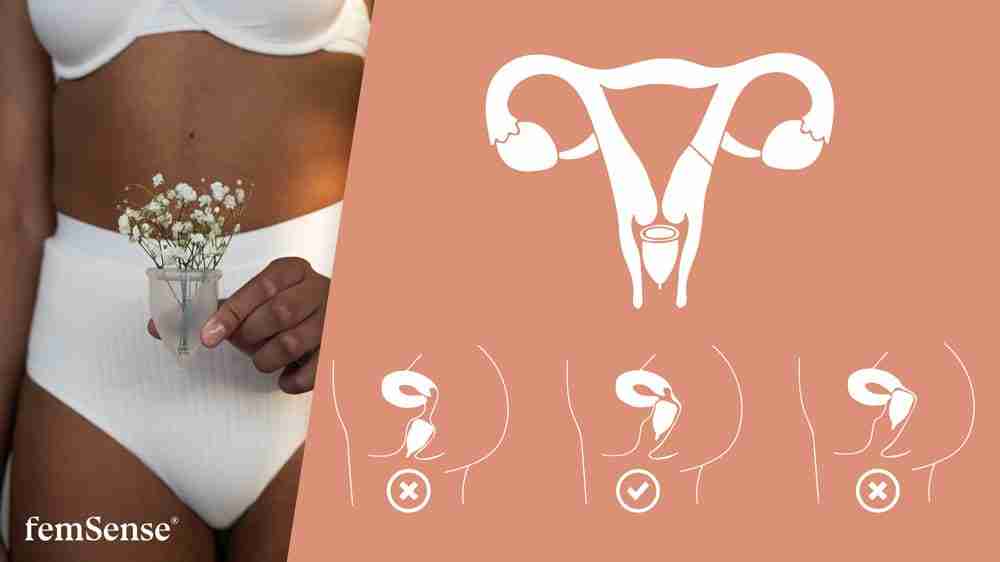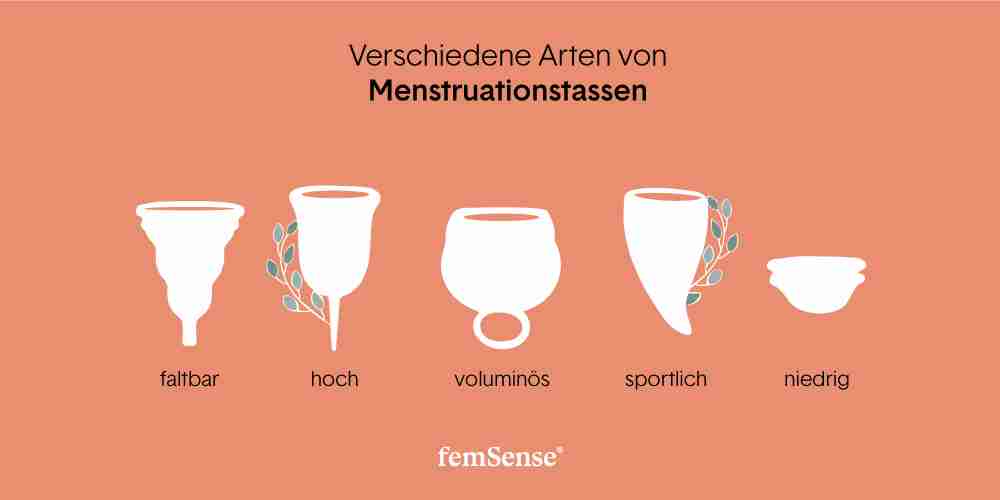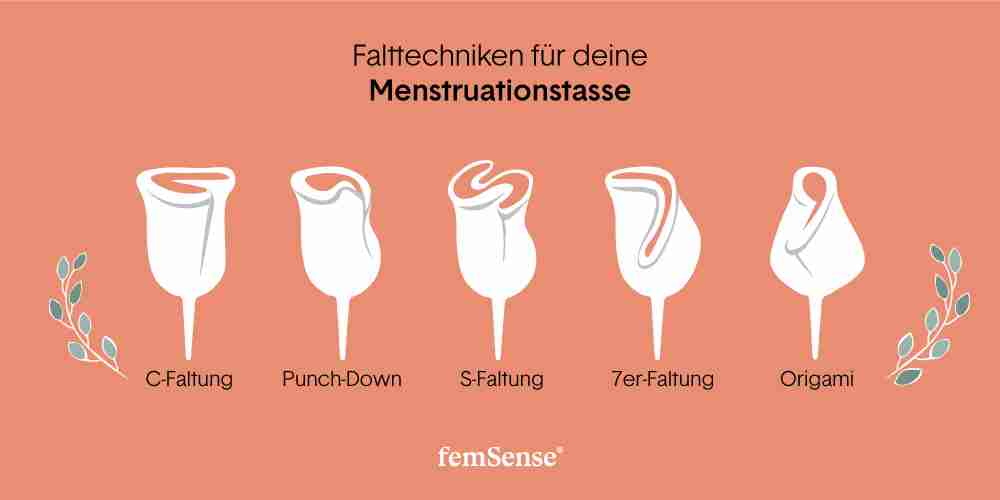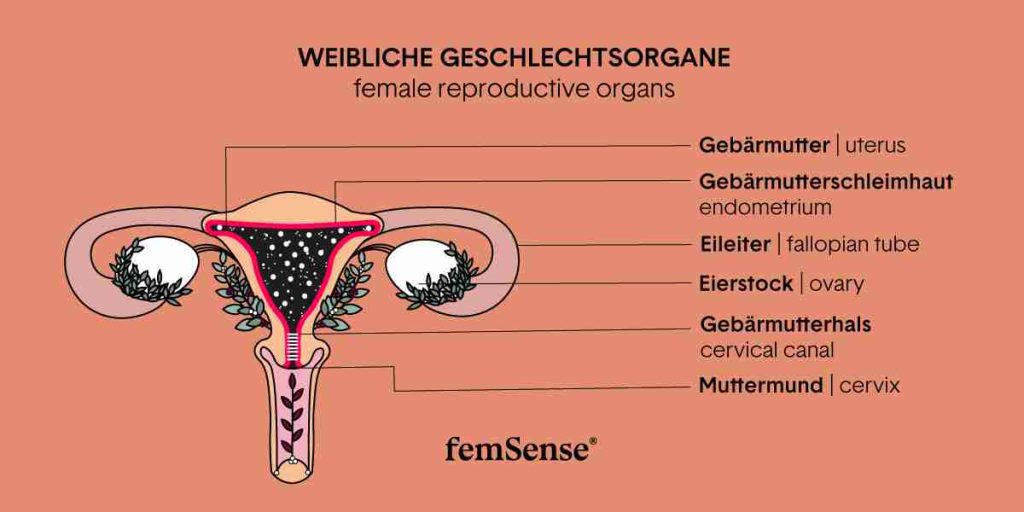
We'll show you how to find the right cup for you and how you too can benefit from its many advantages.
ome women have one thing in common, but hardly ever talk about it: We bleed! And we produce a lot of rubbish in the process. Fortunately, there are more and more alternatives that help us bleed sustainably. The menstrual cup is currently becoming increasingly popular. And although the many advantages are obvious, few topics polarise as much as these small silicone cups. From "wow" to "yuck", you can probably hear every opinion on the subject, even among your own circle of friends.
The difficult thing is that friends and many blogs often recommend a certain cup. But just like with shoes, cups come in all different sizes, lengths, widths and thicknesses - except that with shoes, nobody would think of recommending their own shoe size to everyone else. And of course there is also a lot of fake news: you often hear about a "vacuum", for example. But don't worry, this only refers to a slight vacuum that holds the cup in place.
Yes, you have to dig into yourself a little when using a cup. And yes, you can see your own blood. If this is absolutely unimaginable for you, skip straight to the end of the article to the alternatives. If you however and would like to learn more about the miracle cup, you've come to the right place!
We'll answer all your questions and show you how to find the perfect cup for you.
Cup instead of tampons & co: what are the advantages of menstrual cups?
Good for the environment: Have you ever thought about how many tampons and pads end up in the bin every period - and how many that is per year, calculated for all women in the world? There are MANY. One cup can replace up to 2000 disposable products in its lifetime! The blood is simply tipped directly into the toilet, the cup is washed out and reused. A cup is sustainable and "zero waste", and you'll notice that at home too: no more smelly rubbish bin in the bathroom!
Good for your wallet: All these disposable products naturally cost money. Women in Austria spend an average of €1230 on hygiene products alone. All in all, however, the rule is even more expensive - A bitic statistic shows that a woman needs around £34 (approx. €40) per period, if you include painkillers, sweets and new underwear (due to bloody hoppalas), for example. A cup, on the other hand, costs between £15 and £30 and can be used for 5-10 years. An investment that pays for itself very quickly!
Good for your health: Tampons & co. can contain substances that are harmful to health: Bleaching agents, artificial fragrances, plasticisers... All substances that we don't necessarily want directly on our mucous membranes. Menstrual cups, on the other hand, are usually made of pure medical silicone. They are ideal for women who are prone to allergies, infections and fungi, as they collect the blood instead of absorbing any liquid and drying out the vagina. The cup also prevents germs from entering the body through chlorine or seawater when bathing.
Fewer menstrual crampsIt has not been proven, but many women report less abdominal cramps and shorter periods when using a cup. This theory is explained by the slight negative pressure: the body has to exert less force and cramps to get rid of blood, mucous membrane and tissue.
Invisible: A matching cup is a close, reliable companion for sports and swimming. No more blue laces peeking out of your bikini bottoms!
Light luggage on holiday: Packing whole packs full of tampons, pads and panty liners? With a cup, that's a thing of the past.
Are there any disadvantages?
Once you have found the right cup and use it, there are hardly any disadvantages. Allergies are extremely rare, as the vast majority of cups are made of medical silicone. And even then there are cups made of natural rubber/latex or TPE as an alternative. The important thing is to know: You should be prepared to take a closer look at your body and the period itself and, as already mentioned, you will have some "blood on your hands" from time to time.
Which cup suits me?
Oft hört man “Ich finde das Prinzip ja super, aber bei mir funktioniert es einfach nicht…” Die Tasse läuft aus, drückt, lugt unten raus oder ist so kurz, dass man kaum noch drankommt. Die wenigsten wissen, dass – wie Kleider oder Schuhe – auch Cups genau passen müssen. Denn nur weil die beste Freundin Schuhe in Größe 38 trägt, heißt es noch lange nicht, dass sie dir ebenfalls perfekt passen. Mit Tassen ist es genau gleich! Folgende Punkte können dir dabei helfen, den “Cup für’s Leben” zu finden. Oder zumindest deinen “Lebensabschnitts-Cup”. 🙂 Am besten schreibst du eine Regelblutung lang mit, bevor du dich für einen entscheidest.

1. intensity of the haemorrhage
The heavier the bleeding, the wider and more bulbous the cup should be, as it can simply collect more blood. You should also not forget that the cervix partly protrudes into the cup and takes up space! So if you used to need super tampons and no longer want to run to the toilet every hour, you should opt for a more spherical cup.
2. important: the height of the cervix
Have you ever heard the horror story where someone had to have their cup removed by the gynaecologist because they couldn't reach it themselves? That can only happen to you if you take a cup that is far too short at random but have a high cervix. Erm... High cervix?
That's right. Another thing that hardly anyone knows - the cervix is not the end of the vagina, but usually protrudes laterally into the vaginal canal. It can easily be felt with a finger, it feels like a smooth, soft tip of the nose with a small hole in the centre. And the important thing about it: it can "wander"! It likes to change its position, especially during your period. For example, it can be up to a centimetre away from the vaginal entrance during your period. You then need a very short cup, from which you may even have to cut off the stem if you don't want to feel it while sitting. However, if the cervix rises so high that it can no longer be felt with a finger, it is important to choose a long cup with a long stem.
It is therefore highly recommended to note the height of the cervix in the morning and evening for one period (measure the position on your finger) so that there are no surprises!
3. strength of the pelvic floor muscles
Cups not only come in different shapes, sizes and lengths, but also in different hardnesses. This is due to another important factor: your pelvic floor. If it is too strong, it can squeeze your cup at the slightest movement. The result: it leaks. If, on the other hand, the cup is too firm for your pelvic floor, you may feel it and it may squeeze you uncomfortably.
It is not easy to assess the strength of the pelvic floor. Generally speaking, the more sporty you are, the stronger your inner muscles will be. Pilates, yoga and horse riding in particular or endurance sports such as jogging, swimming and cycling strengthen the pelvic floor.
You can test your pelvic floor muscles by inserting a (clean!) finger and squeezing the muscles there as if you were trying to hold your finger. If you can clearly feel a contraction and an upward lift, your pelvic floor is intact. If not, and you unintentionally leak urine when sneezing or jumping, for example, or you haven't done any postnatal exercises after pregnancy, pelvic floor training is called for.
4. virgin or mother
Teenagers who may not yet be sexually active can also use menstrual cups. However, just like with tampons, insertion can be a little uncomfortable. A rather small cup is recommended here - but the other factors such as the height of the cervix and the like should still be taken into account so that the first experience with the cup is not a traumatic one.
Many women need a different cup after giving birth than before, as the vagina, pelvic floor and bleeding strength can change. It is best to observe your period for a while after it has resumed and collect data on the first 3 points before buying a new cup at random.
How do I use my cup?
There are various folding techniques that depend on the shape of the cup, among other things. From the C-fold to the push-down fold to the S-shape, everything is possible to make the cup smaller and easier to insert. It's best to just try it out!

A good tip is to feel the cervix before insertion. Because if you know where the cervix is currently located (above? slightly to the left or right? far below?), you can push the cup directly in front of it. If you push it past, the blood cannot be collected.

Our tip for "bloody beginners": Try the first insertion in the shower! Fold up the cup, insert it carefully, let it pop open and push it in front of the cervix. The warm water is relaxing and there's no mess... Even if everything is a little more sensitive than usual during your period - it's best to try it out for the first time during your period. The tissue will be softer and the cup will slide better.
Incidentally, the cup is sitting correctly when you can no longer feel it and it is fully open. You can check this by trying to turn it slightly inside you. If it has not yet popped open completely (usually you won't hear any popping, just a gentle sucking sound), you can carefully run your finger in a circle around the rim of the cup. This will allow some more air to come in and it can finish opening.
How long can I wear them?
In general, you should empty the cup when it is full, but at least twice a day. Under no circumstances should you leave it in for longer than 12 hours at a time. Depending on its size, a cup can hold up to 35ml, which is about 3 times as much blood as a tampon. So if you used to have to change your OB every hour, a cup will last you at least 3 hours.
A cup made of medical silicone has a recommended service life of three years. However, if you always clean it hygienically and store it well - i.e. dry and out of direct sunlight - it can easily last for ten years.
How do I remove them again?
First of all: wash your hands! Then it's best to take it out over the toilet so that you can tip the collected blood away straight away. Please don't just pull out by the stem or ring to remove it - the slight vacuum should be released first. But you'll soon get the hang of it: you can press down gently with the base of your pelvis. You can now use your thumb and index finger to press them together a little and pull them out.
Can my cup get "lost" inside me?
No, don't worry. Your body is not a black hole. But - as already mentioned above - a cup that is too short for your body may well mean that you can't reach it easily. Then it's time to take a hot bath, relax and push it out in a deep squat as a so-called "cup birth".
What is the best way to clean them?
It's easy at home in the bathroom: Simply tip out in the toilet and rinse in the sink with cold, clean water. The water should be cold so that the cup does not discolour so quickly due to the blood. It will also pop open more easily after insertion.
Things can get tricky on the road: Insensitive people simply wipe out the cup with toilet paper and put it straight back in. Others take a bottle of drinking water with them to the loo. A good life hack is a Tupperware container filled with water. Simply place the emptied cup inside, close the lid and shake the can, pour the water away and reinsert the cup. Special cleaning cloths are actually avoidable waste, but they are very practical when travelling and won't harm you or your cup. However, avoid aggressive cleaning agents or perfumed soaps so as not to damage the surface of the medical silicone. It's more hygienic and prolongs the life of your cup.
No matter which method you choose: Clean hands are an absolute must in any case! So please always wash your hands BEFORE removing the cup.
Before and after each period it is important to boil them in a pot of water for a few minutes. If the water contains limescale, you can add a dash of vinegar or lemon juice to prevent a layer of limescale from forming on the cup. If you have an intimate infection during use, a boiling bath for at least 15-20 minutes will rid your cup of all germs and bacteria.
Any discolouration of the material can be removed with various tricks: Tooth cleaning tabs, vinegar, citric acid or hydrogen peroxide are just a few of the many possibilities.
Where can I find the perfect cup for me?
You now know what's important in theory, but would like some help finding the right cup for you? We've got you covered! We've discovered a great site for you. At Ladyways* experts who know pretty much every cup in the world will advise you based on your individual details. There are also these German Facebook group*where you get support from thousands of members.
What alternatives are there to cups?
There are now many options* for anyone who wants to do something good for nature and get away from pads, sanitary towels and the like.
1.Period Panties for example, are already widely known and are worn alone or as a "back-up" to cups. Natural sponges are a wonderful alternative. Many people swear by these "soft tampons" for sex during their period - cups have to be removed beforehand.
2. you have probably already heard of Fabric bandages but do you know...
3. Fabric tampons? These are pieces of cotton fabric that can be rolled up and tied like conventional tampons. The only difference is that you don't throw them away afterwards, but wash and reuse them.
femSense tells you WHEN
Whether it's a cup or other alternatives, it's important to know when you need them. After all, nothing is more unpleasant than being surprised by your period while travelling. A reliable cycle tracker like femSense not only tells you when you are fertile and when you are not: with femSense, you always know when your period is due and can prepare yourself accordingly. Boil the cup, stock up on chocolate, get the camomile tea ready or pack the heating pad... We'll help you with the timing. The femSense cycle app tells you WHEN - and free of charge!
If you want to get to know your cycle even better and know if and when you are ovulating, we can also recommend our femSense sensor patches. You can find out more here!
*unbezahlte Werbung aus Überzeugung 😉
Sources:
Regularly expensive: how much the period costs (2023)
Average amount of money spent per month on periods by women in the United Kingdom (2023)
Donohoe (2023), Can menstrual cups shorten periods?





Leave a Reply